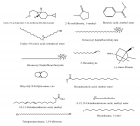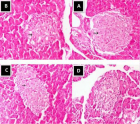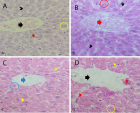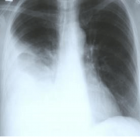Abstract
Research Article
Evaluation of the Antihyperglycaemic Activities, Safety and Phytochemical Profile of Celtis zenkeri Engl
Marcus Durojaye Ayoola*, Akintunde Samuel Odediran, Samson Oluwaseyi Famuyiwa, Moyinoluwa Oluwagbemi, Lateefat Idowu Afolabi, Farouk Adedeji Oladoja and Oluwabusayo Emmanuel Kasumu
Published: 14 July, 2023 | Volume 7 - Issue 1 | Pages: 036-044
Objective: The study evaluated the hyperglycaemia-lowering effects, safety, and phytochemical profile of Celtis zenkeri leaf extract in order to justify its antidiabetic folkloric usage.
Methods: Modified OECD test guidelines were used to assess its acute and sub-acute toxicity while its effect on blood parameters such as blood glucose, and haematological and biochemical levels were evaluated using appropriate assays. Both in vitro and in vivo antihyperglycaemic assays were used for the antidiabetic studies while histology of the pancreas, liver, and kidney of the rats was examined after treatment with the extract at 250, 500, and 1000 mg/kg for 21 days. GC-MS analysis was used to determine the chemical constituents of the extract.
Results: The results obtained showed that the leaf extract of C. zenkeri was not toxic in rats at 5000 mg/kg. It elicited a significant decrease in the blood glucose levels of the animals but did not affect the haematological and biochemical components of normal rats. It significantly inhibited α-amylase and α-glucosidase actions and gave comparable activity to glibenclamide (5 mg/kg) at all time points at 200 and 400 mg/kg. The extract comparably reduced blood glucose levels with glibenclamide at 100 and 200 mg/kg on days 10 and 14 in drug-induced diabetic rats and maintained the histoarchitecture of the liver, kidney, and pancreas at 250 and 500 mg/kg.
Conclusion: The study justified the ethnomedicinal use of C. zenkeri in diabetes management.
Read Full Article HTML DOI: 10.29328/journal.apps.1001042 Cite this Article Read Full Article PDF
Keywords:
Diabetes mellitus; Toxicological studies; Chemical constituents; Celtis zenkeri Engl
References
- Trease GE, Evans WC. Pharmacognosy. Fifteenth edition, Edinburgh, London, New York. 2002; 1-2.
- Lai PK, Roy J. Antimicrobial and chemopreventive properties of herbs and spices. Curr Med Chem. 2004 Jun;11(11):1451-60. doi: 10.2174/0929867043365107. PMID: 15180577.
- Tapsell LC, Hemphill I, Cobiac L, Patch CS, Sullivan DR, Fenech M, Roodenrys S, Keogh JB, Clifton PM, Williams PG, Fazio VA, Inge KE. Health benefits of herbs and spices: the past, the present, the future. Med J Aust. 2006 Aug 21;185(S4):S1-S24. doi: 10.5694/j.1326-5377.2006.tb00548.x. PMID: 17022438.
- Sofowora A. Medicinal Plants and Traditional Medicine I. Africa. 3rd edition, Spectrum Books Ltd., Ibadan, 2008; 117-133.
- Zargari A. Medicinal Plants. Tehran University Press. 1992; 889.
- Essien C, Oteng-Amoako AA. Celtis zenkeri Engl. Record from PROTA (Plant Resources of Tropical Africa / Ressources végétales de l’Afrique tropicale), Wageningen, Netherlands 2012.
- Adjanohoun E, Aké Assi L, Adjakidjè V. Contribution to ethnobotanical and floristic studies in the People's Republic of Congo, 2019. Médecine d'Afrique Noire, 65(6): 344-354.
- Lowe HI, Khan MA, Geevarghese S. The West African Nettle Tree (Celtis zenkeri) in the Spotlight: A Review of Its Traditional Uses. Phytochemistry and Pharmacology. 2021; 10(7): 1442.
- Okoye FBC, Akunneh-Wariso C, Ihedioha NJ. Phytochemical and antioxidant analysis of the stem bark extract of Celtis zenkeri, 2021, International Journal of Plant and Animal Sciences. 9(1): 1-9.
- Okpala E, Onocha PA, Ali M. Zenkeramide: a new iso-benzofuranone propanamide and urease inhibitory constituents of Celtis zenkeri Engl stem bark (Ulmaceae). Trends in Phytochemical Research. 202;; 6(2): 137-144.
- Adeniji AJ, Adewale OB, Adekeye BT, Adekoya AO, Adeniji OB, Ajayi AM. In vitro cytotoxicity and apoptotic effect of Celtis zenkeri leaf extract against MCF-7 human breast cancer cell line. Journal of Medicinal Plants for Economic Development. 2020; 4(1): 1-9.
- Akinpelu OA, Omololu-Aso J, OkohA I. Cytotoxicity and apoptosis-inducing effect of Celtis zenkeri leaves extract against HeLa cervical cancer cell lines. 2021. Journal of Complementary and Integrative Medicine. 18(2): 1-9.
- Folarin RO, Alade GO, Olorunsogo OO, Oridupa OA. Antidiabetic and hypolipidemic effect of methanol extract of Celtis zenkeri leaves in streptozotocin-induced diabetic rats, South African Journal of Botany. 2021; 140: 206-211.
- Tchoumbougnang F, Ekué MRM, Mapongmetsem PM, Wouatsa NA. Antifungal activity of the extracts of bark from Celtis zenkeri. International Journal of Microbiology and Mycology. 2019; 8(4): 396-402.
- Oyedeji AO, Adeyemi OA, Aremu OJ, Afolayan AJ. Evaluation of Phytochemical Composition, Antioxidant and Antimicrobial Activities of Celtis zenkeri. Journal of Medicinal Plants Research. 2020; 14(2): 63.
- Okpala EO, Onocha P, Ali MS, Ur-Rehmenc SZ, Lateef M. Antioxidant activity of phytol dominated stem bark and leaf essential oils of Celtis zenkeri Engl. Natural Product Research. 2021; 6(2): 137-144
- The OECD guidelines for the testing of chemicals: 423. Acute Oral Toxicity – Acute Toxic Class Method, 2001.
- Bello OI, Ayoola MD, Obembe O, Akinwunmi KF. Antidiabetic and Toxicity Studies of the Extract of Four Nigerian Medicinal Plants. European Journal of Medicinal Plants. 2020; 33(11):32-45.
- The OECD guidelines for the testing of chemicals: 407. Repeated dose 28-day oral toxicity study in rodents, 2008.
- Hemant S, Tun-Abraham ME, McAlister V. Bidirectional graft-host hematological traffic in liver transplantation. 2019; Hepatobiliary Surgery and Nutrition. 8: 253.
- Friedewald WT, Levy RI, Fredrickson DS. Estimation of the concentration of low-density lipoprotein cholesterol in plasma, without use of the preparative ultracentrifuge. Clin Chem. 1972 Jun;18(6):499-502. PMID: 4337382.
- Joseph BF, Reginald Edward Silverton. Introduction to medical laboratory technology (Butterworth-Heinemann). 2014.
- Bahman N, Leyla A, Hamidreza I. Alpha-amylase inhibitory activities of six Salvia spp. Iranian J. Pharm. Res. 2008; 7:297-303.
- Akinwumi KF, Ayoola MD. Antihyperglycaemic, anti-inflammatory and antioxidant activities of Carica papaya and Citrullus lanatus seeds extracts. Ife Journal of Science. 2018; 20(2):207-218.
- Li T, Zhang XD, Song YW. A microplate-based screening method for alpha-glucosidase inhibitors. Chinese Chin J Clin Pharmaco Ther. 2005; 10:1128-1134.
- Ajileye AJ, Ayoola MD, Elujoba AA, Akinwunmi KF. Antihyperglycaemic and Antioxidant Activities of Sansevieria liberica as Justification for its Antidiabetic Claims. African Journal of Pharmacy and Pharmacology. 2020; 14(3):59-66.
- Ayoola MD, Balogun JO, Famuyiwa FG, Yeboah SO, Famuyiwa SO. Isolation and characterization of 2-hydroxy-3-[4-hydroxyphenyl]-2-propenoic acid and 4-bromophenol from anti-diabetic extract of the root bark of Uvaria afzelii. South African Journal of Botany. 2017; 112:527-532.
- Faloye KO, Ayoola MD, Amos-Tautau BM, Famuyiwa SO. Anti-diabetic activity of convallatoxin isolated from the root bark of Parquetina nigrescence (Afzel.) Bullock (Asclepidaceae), European Journal of Medicinal Plants. 2018; 25(4):1-9.
- Committee for the update of the guide for the care and use of laboratory animals, institute for laboratory animal research, division on earth and life studies, national research council of the national academies. Guide for the Care and Use of Laboratory Animals, 8th ed. The National Academies Press, Washington, DC. 2011.
- Sulaimon LA, Anise EO, Obuotor EM, Samuel AI, Moshood TA, Olajide M, Fatoke T. In vitro antidiabetic potentials, antioxidant activities and phytochemical profile of African black pepper (Piper guineense). Clinical Phytoscience. 2020; 6:1-13.
- Bashir L, Shittu OK, Rotimi AA, Olalekan IA, Kamooru AA, and Ossai PC. Effect of Methanol Extract of Telfairia occcidentalis on Haematological Parameters in Wister Rats. J. Med. Sci. 2015; 15(5):246-250.
- Nathan DM, Buse JB, Davidson MB, Heine RJ, Holman RR, Sherwin R, Zinman B. Management of hyperglycemia in type 2 diabetes: A consensus algorithm for the initiation and adjustment of therapy: a consensus statement from the American Diabetes Association and the European Association for the Study of Diabetes. Diabetes Care. 2006 Aug;29(8):1963-72. doi: 10.2337/dc06-9912. PMID: 16873813.
- Kazeem MI, Adamson JO, Ogunwande IA. Modes of inhibition of α -amylase and α -glucosidase by aqueous extract of Morinda lucida Benth leaf. Biomed Res Int. 2013;2013:527570. doi: 10.1155/2013/527570. Epub 2013 Dec 24. PMID: 24455701; PMCID: PMC3884628.
- Shodehinde SA, Ademiluyi AO, Oboh G, Akindahunsi AA. Contribution of Musa paradisiaca in the inhibition of α-amylase, α-glucosidase and Angiotensin-I converting enzyme in streptozotocin induced rats. Life Sci. 2015 Jul 15;133:8-14. doi: 10.1016/j.lfs.2015.03.026. Epub 2015 Apr 25. PMID: 25921768.
- Alqahtani AS, Hidayathulla S, Rehman MT, ElGamal AA, Al-Massarani S, Razmovski-Naumovski V, Alqahtani MS, El Dib RA, AlAjmi MF. Alpha-Amylase and Alpha-Glucosidase Enzyme Inhibition and Antioxidant Potential of 3-Oxolupenal and Katononic Acid Isolated from Nuxia oppositifolia. Biomolecules. 2019 Dec 30;10(1):61. doi: 10.3390/biom10010061. PMID: 31905962; PMCID: PMC7022278.
- Verspohl EJ. Recommended testing in diabetes research. Planta Med. 2002 Jul;68(7):581-90. doi: 10.1055/s-2002-32894. PMID: 12142989.
- Adebajo AC, Ayoola MD, Odediran SA, Aladesanmi AJ, Schmidt TJ, Verspohl EJ. Evaluation of ethnomedical claim III: anti-hyperglycemic activities of Gongronema latifolium root and stem. J Diabetes. 2013 Sep;5(3):336-43. doi: 10.1111/1753-0407.12019. Epub 2013 May 28. PMID: 23217111.
- Adebajo AC, Ayoola MD, Obagbemi OR, Obuotor EM, Ogunsina MO, Verspohl EJ. Antihyperglycemic and Antioxidant Activities of Eugenia uniflora Leaf: Evaluation of Ethnomedicinal Claims IV, Ife Journal of Science and Technology. 2013b; 1(1):1-18.
- Adebajo AC, Iwalewa EO, Obuotor EM, Ibikunle GF, Omisore NO, Adewunmi CO, Obaparusi OO, Klaes M, Adetogun GE, Schmidt TJ, Verspohl EJ. Pharmacological properties of the extract and some isolated compounds of Clausena lansium stem bark: anti-trichomonal, antidiabetic, anti-inflammatory, hepatoprotective and antioxidant effects. J Ethnopharmacol. 2009 Feb 25;122(1):10-9. doi: 10.1016/j.jep.2008.11.015. Epub 2008 Nov 27. PMID: 19095054.
- Luzi L, Pozza G. Glibenclamide: an old drug with a novel mechanism of action? Acta Diabetol. 1997 Dec;34(4):239-44. doi: 10.1007/s005920050081. PMID: 9451465.
- Shettar AK, Sateesh MK, Kaliwal BB, Vedamurthy AB. In vitro antidiabetic activities and GC-MS phytochemical analysis of Ximenia americana extracts, South African Journal of Botany. 2017; 111:202-211.
- Al Kury LT, Abdoh A, Ikbariah K, Sadek B, Mahgoub M. In Vitro and In Vivo Antidiabetic Potential of Monoterpenoids: An Update. Molecules. 2021 Dec 29;27(1):182. doi: 10.3390/molecules27010182. PMID: 35011414; PMCID: PMC8746715.
- Tan XC, Chua KH, Ravishankar Ram M, Kuppusamy UR. Monoterpenes: Novel insights into their biological effects and roles on glucose uptake and lipid metabolism in 3T3-L1 adipocytes. Food Chem. 2016 Apr 1;196:242-50. doi: 10.1016/j.foodchem.2015.09.042. Epub 2015 Sep 12. PMID: 26593489.
- Guimarães AC, Meireles LM, Lemos MF, Guimarães MCC, Endringer DC, Fronza M, Scherer R. Antibacterial Activity of Terpenes and Terpenoids Present in Essential Oils. Molecules. 2019 Jul 5;24(13):2471. doi: 10.3390/molecules24132471. PMID: 31284397; PMCID: PMC6651100.
- Kozioł A, Stryjewska A, Librowski T, Sałat K, Gaweł M, Moniczewski A, Lochyński S. An overview of the pharmacological properties and potential applications of natural monoterpenes. Mini Rev Med Chem. 2014;14(14):1156-68. doi: 10.2174/1389557514666141127145820. PMID: 25429661.
Figures:

Figure 1

Figure 2

Figure 3

Figure 4

Figure 5
Similar Articles
-
Evaluation of the Antihyperglycaemic Activities, Safety and Phytochemical Profile of Celtis zenkeri EnglMarcus Durojaye Ayoola*, Akintunde Samuel Odediran, Samson Oluwaseyi Famuyiwa, Moyinoluwa Oluwagbemi, Lateefat Idowu Afolabi, Farouk Adedeji Oladoja, Oluwabusayo Emmanuel Kasumu. Evaluation of the Antihyperglycaemic Activities, Safety and Phytochemical Profile of Celtis zenkeri Engl. . 2023 doi: 10.29328/journal.apps.1001042; 7: 036-044
-
Benefits of using SLGT2 Inhibitors for Patients with CDK and DM2 to Reduce Mortality RisksPandora Eloa Oliveira Fonseca, Jeremias Aguiar Azevedo, Sara Maria Gomes Bié, Sávio Benvindo Ferreira*. Benefits of using SLGT2 Inhibitors for Patients with CDK and DM2 to Reduce Mortality Risks. . 2024 doi: 10.29328/journal.apps.1001055; 8: 041-046
Recently Viewed
-
Sinonasal Myxoma Extending into the Orbit in a 4-Year Old: A Case PresentationJulian A Purrinos*, Ramzi Younis. Sinonasal Myxoma Extending into the Orbit in a 4-Year Old: A Case Presentation. Arch Case Rep. 2024: doi: 10.29328/journal.acr.1001099; 8: 075-077
-
Timing of cardiac surgery and other intervention among children with congenital heart disease: A review articleChinawa JM*,Adiele KD,Ujunwa FA,Onukwuli VO,Arodiwe I,Chinawa AT,Obidike EO,Chukwu BF. Timing of cardiac surgery and other intervention among children with congenital heart disease: A review article. J Cardiol Cardiovasc Med. 2019: doi: 10.29328/journal.jccm.1001047; 4: 094-099
-
Advancing Forensic Approaches to Human Trafficking: The Role of Dental IdentificationAiswarya GR*. Advancing Forensic Approaches to Human Trafficking: The Role of Dental Identification. J Forensic Sci Res. 2025: doi: 10.29328/journal.jfsr.1001076; 9: 025-028
-
Scientific Analysis of Eucharistic Miracles: Importance of a Standardization in EvaluationKelly Kearse*,Frank Ligaj. Scientific Analysis of Eucharistic Miracles: Importance of a Standardization in Evaluation. J Forensic Sci Res. 2024: doi: 10.29328/journal.jfsr.1001068; 8: 078-088
-
Toxicity and Phytochemical Analysis of Five Medicinal PlantsJohnson-Ajinwo Okiemute Rosa*, Nyodee, Dummene Godwin. Toxicity and Phytochemical Analysis of Five Medicinal Plants. Arch Pharm Pharma Sci. 2024: doi: 10.29328/journal.apps.1001054; 8: 029-040
Most Viewed
-
Evaluation of Biostimulants Based on Recovered Protein Hydrolysates from Animal By-products as Plant Growth EnhancersH Pérez-Aguilar*, M Lacruz-Asaro, F Arán-Ais. Evaluation of Biostimulants Based on Recovered Protein Hydrolysates from Animal By-products as Plant Growth Enhancers. J Plant Sci Phytopathol. 2023 doi: 10.29328/journal.jpsp.1001104; 7: 042-047
-
Sinonasal Myxoma Extending into the Orbit in a 4-Year Old: A Case PresentationJulian A Purrinos*, Ramzi Younis. Sinonasal Myxoma Extending into the Orbit in a 4-Year Old: A Case Presentation. Arch Case Rep. 2024 doi: 10.29328/journal.acr.1001099; 8: 075-077
-
Feasibility study of magnetic sensing for detecting single-neuron action potentialsDenis Tonini,Kai Wu,Renata Saha,Jian-Ping Wang*. Feasibility study of magnetic sensing for detecting single-neuron action potentials. Ann Biomed Sci Eng. 2022 doi: 10.29328/journal.abse.1001018; 6: 019-029
-
Pediatric Dysgerminoma: Unveiling a Rare Ovarian TumorFaten Limaiem*, Khalil Saffar, Ahmed Halouani. Pediatric Dysgerminoma: Unveiling a Rare Ovarian Tumor. Arch Case Rep. 2024 doi: 10.29328/journal.acr.1001087; 8: 010-013
-
Physical activity can change the physiological and psychological circumstances during COVID-19 pandemic: A narrative reviewKhashayar Maroufi*. Physical activity can change the physiological and psychological circumstances during COVID-19 pandemic: A narrative review. J Sports Med Ther. 2021 doi: 10.29328/journal.jsmt.1001051; 6: 001-007

HSPI: We're glad you're here. Please click "create a new Query" if you are a new visitor to our website and need further information from us.
If you are already a member of our network and need to keep track of any developments regarding a question you have already submitted, click "take me to my Query."


















































































































































